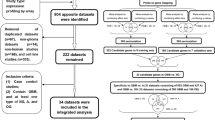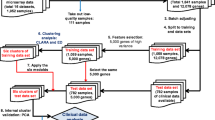Abstract
Microarray analysis in glioblastomas is done using either cell lines or patient samples as starting material. A survey of the current literature points to transcript-based microarrays and immunohistochemistry (IHC)-based tissue microarrays as being the preferred methods of choice in cancers of neurological origin. Microarray analysis may be carried out for various purposes including the following:
-
i.
To correlate gene expression signatures of glioblastoma cell lines or tumors with response to chemotherapy (DeLay et al., Clin Cancer Res 18(10):2930–2942, 2012)
-
ii.
To correlate gene expression patterns with biological features like proliferation or invasiveness of the glioblastoma cells (Jiang et al., PLoS One 8(6):e66008, 2013)
-
iii.
To discover new tumor classificatory systems based on gene expression signature, and to correlate therapeutic response and prognosis with these signatures (Huse et al., Annu Rev Med 64(1):59–70, 2013; Verhaak et al., Cancer Cell 17(1):98–110, 2010)
While investigators can sometimes use archived tumor gene expression data available from repositories such as the NCBI Gene Expression Omnibus to answer their questions, new arrays must often be run to adequately answer specific questions. Here, we provide a detailed description of microarray methodologies, how to select the appropriate methodology for a given question, and analytical strategies that can be used. Experimental methodology for protein microarrays is outside the scope of this chapter, but basic sample preparation techniques for transcript-based microarrays are included here.
Access this chapter
Tax calculation will be finalised at checkout
Purchases are for personal use only
Similar content being viewed by others
References
DeLay M, Jahangiri A, Carbonell WS, Hu YL, Tsao S, Tom MW, Paquette J, Tokuyasu TA, Aghi MK (2012) Microarray analysis verifies two distinct phenotypes of glioblastomas resistant to antiangiogenic therapy. Clin Cancer Res 18(10):2930–2942. doi:10.1158/1078-0432.ccr-11-2390
Jiang T, Tie X, Han S, Meng L, Wang Y, Wu A (2013) NFAT1 Is highly expressed in, and regulates the invasion of, glioblastoma multiforme cells. PLoS One 8(6):e66008. doi:10.1371/journal.pone.0066008
Huse JT, Holland E, DeAngelis LM (2013) Glioblastoma: molecular analysis and clinical implications. Annu Rev Med 64(1):59–70. doi:10.1146/annurev-med-100711-143028
Verhaak RG, Hoadley KA, Purdom E, Wang V, Qi Y, Wilkerson MD, Miller CR, Ding L, Golub T, Mesirov JP, Alexe G, Lawrence M, O’Kelly M, Tamayo P, Weir BA, Gabriel S, Winckler W, Gupta S, Jakkula L, Feiler HS, Hodgson JG, James CD, Sarkaria JN, Brennan C, Kahn A, Spellman PT, Wilson RK, Speed TP, Gray JW, Meyerson M, Getz G, Perou CM, Hayes DN, Cancer Genome Atlas Research Network (2010) Integrated genomic analysis identifies clinically relevant subtypes of glioblastoma characterized by abnormalities in PDGFRA, IDH1, EGFR, and NF1. Cancer Cell 17(1):98–110. doi:10.1016/j.ccr.2009.12.020
Bao ZS, Zhang CB, Wang HJ, Yan W, Liu YW, Li MY, Zhang W (2013) Whole-genome mRNA expression profiling identifies functional and prognostic signatures in patients with mesenchymal glioblastoma multiforme. CNS Neurosci Ther 19(9):714–720. doi:10.1111/cns.12118
Tivnan A, McDonald KL (2013) Current progress for the use of miRNAs in glioblastoma treatment. Mol Neurobiol. doi:10.1007/s12035-013-8464-0
Engstrom PG, Tommei D, Stricker SH, Ender C, Pollard SM, Bertone P (2012) Digital transcriptome profiling of normal and glioblastoma-derived neural stem cells identifies genes associated with patient survival. Genome Med 4(10):76. doi:10.1186/gm377
Ernst A, Hofmann S, Ahmadi R, Becker N, Korshunov A, Engel F, Hartmann C, Felsberg J, Sabel M, Peterziel H, Durchdewald M, Hess J, Barbus S, Campos B, Starzinski-Powitz A, Unterberg A, Reifenberger G, Lichter P, Herold-Mende C, Radlwimmer B (2009) Genomic and expression profiling of glioblastoma stem cell-like spheroid cultures identifies novel tumor-relevant genes associated with survival. Clin Cancer Res 15(21):6541–6550. doi:10.1158/1078-0432.ccr-09-0695
Sooman L, Ekman S, Andersson C, Kultima HG, Isaksson A, Johansson F, Bergqvist M, Blomquist E, Lennartsson J, Gullbo J (2013) Synergistic interactions between camptothecin and EGFR or RAC1 inhibitors and between imatinib and Notch signaling or RAC1 inhibitors in glioblastoma cell lines. Cancer Chemother Pharmacol 72(2):329–340. doi:10.1007/s00280-013-2197-7
Zeeberg BR, Kohn KW, Kahn A, Larionov V, Weinstein JN, Reinhold W, Pommier Y (2012) Concordance of gene expression and functional correlation patterns across the NCI-60 cell lines and the cancer genome atlas glioblastoma samples. PLoS One 7(7):e40062, doi: 10.1371/journal.pone.0040062.g001. 10.1371/journal.pone.0040062.t001. 10.1371/journal.pone.0040062.t002
Quann K, Gonzales DM, Mercier I, Wang C, Sotgia F, Pestell RG, Lisanti MP, Jasmin J-F (2013) Caveolin-1 is a negative regulator of tumor growth in glioblastoma and modulates chemosensitivity to temozolomide. Cell Cycle 12(10):1510–1520. doi:10.4161/cc.24497
Tarca ALRRDS (2006) Analysis of microarray experiments of gene expression profiling. Am J Obstet Gynaecol 192(2):15
Hartmann M, Roeraade J, Stoll D, Templin MF, Joos TO (2009) Protein microarrays for diagnostic assays. Anal Bioanal Chem 393(5):1407–1416. doi:10.1007/s00216-008-2379-z
Solomon O, Oren S, Safran M, Deshet-Unger N, Akiva P, Jacob-Hirsch J, Cesarkas K, Kabesa R, Amariglio N, Unger R, Rechavi G, Eyal E (2013) Global regulation of alternative splicing by adenosine deaminase acting on RNA (ADAR). RNA 19(5):591–604. doi:10.1261/rna.038042.112
Emig D, Salomonis N, Baumbach J, Lengauer T, Conklin BR, Albrecht M (2010) AltAnalyze and DomainGraph: Analyzing and visualizing exon expression data. Nucleic Acids Res 38:W755–W762
Salomonis N, Schlieve CR, Pereira L, Wahlquist C, Colas A, Zambon AC, Vranizan K, Spindler MJ, Pico AR, Cline MS, et al. (2010) Alternative splicing regulates mouse embryonic stem cell pluripotency and differentiation. Proc Natl Acad Sci 107:10514–10519
Lin Y, Zhang G, Zhang J, Gao G, Li M, Chen Y, Wang J, Li G, Song S-W, Qiu X, Wang Y, Jiang T (2013) A panel of four cytokines predicts the prognosis of patients with malignant gliomas. J Neuro-Oncol 114(2):199–208. doi:10.1007/s11060-013-1171-x
Godoy PR, Mello SS, Magalhaes DA, Donaires FS, Nicolucci P, Donadi EA, Passos GA, Sakamoto-Hojo ET (2013) Ionizing radiation-induced gene expression changes in TP53 proficient and deficient glioblastoma cell lines. Mutat Res 756(1–2):46–55. doi:10.1016/j.mrgentox.2013.06.010
Matson RS, Wadia PP, Miklos DB, Song Y, Wang D, Yamada M, Martinsky T (2009) Microarray methods and protocols. CRC Press, Boca Raton, FL
Subramanian A, Tamayo P, Mootha VK, Mukherjee S, Ebert BL, Gillette MA, Paulovich A, Pomeroy SL, Golub TR, Lander ES, Mesirov JP (2005) Gene set enrichment analysis: a knowledge-based approach for interpreting genome-wide expression profiles. Proc Natl Acad Sci U S A 102(43):15545–15550. doi:10.1073/pnas.0506580102
Doerks T, Copley RR, Schultz J, Ponting CP, Bork P (2002) Systematic identification of novel protein domain families associated with nuclear functions. Genome Res 12(1):47–56, 10.1101/
Author information
Authors and Affiliations
Corresponding author
Editor information
Editors and Affiliations
Rights and permissions
Copyright information
© 2015 Springer Science+Business Media New York
About this protocol
Cite this protocol
Bhawe, K.M., Aghi, M.K. (2015). Microarray Analysis in Glioblastomas. In: Guzzi, P. (eds) Microarray Data Analysis. Methods in Molecular Biology, vol 1375. Humana Press, New York, NY. https://doi.org/10.1007/7651_2015_245
Download citation
DOI: https://doi.org/10.1007/7651_2015_245
Published:
Publisher Name: Humana Press, New York, NY
Print ISBN: 978-1-4939-3172-9
Online ISBN: 978-1-4939-3173-6
eBook Packages: Springer Protocols




